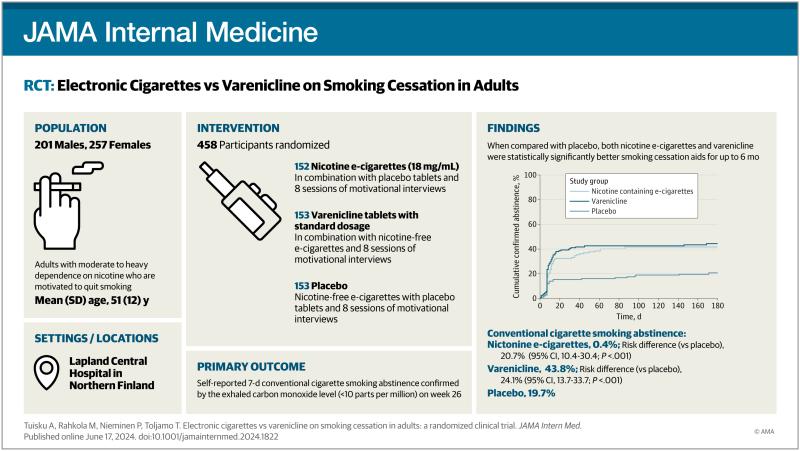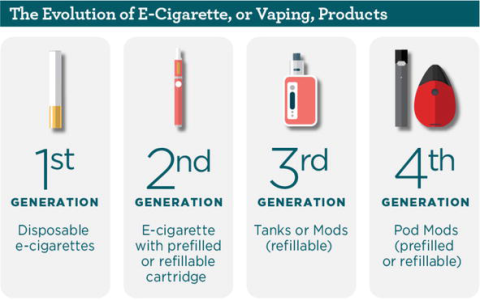Both electronic cigarettes (e-cigarettes) and varenicline are utilized as aids for smoking cessation in adults, but they differ significantly in their mechanisms, efficacy, and safety profiles. A healthcare professional should be consulted to determine the most appropriate option for an individual.
Electronic Cigarettes (E-cigarettes)
Mechanism: E-cigarettes are battery-operated devices that heat a liquid (e-liquid), which usually contains nicotine, flavorings, and other chemicals, to create an aerosol that is inhaled. They aim to replace some of the behavioral, sensory, and nicotine-related aspects of smoking conventional cigarettes.

Efficacy:
- Some randomized controlled trials suggest that e-cigarettes, particularly newer generation devices with more efficient nicotine delivery, can be more effective for smoking cessation than traditional nicotine replacement therapy (NRT) when used with behavioral support.
- Effectiveness can vary based on device type, e-liquid nicotine concentration, frequency of use, and individual user characteristics.
- Many users may continue to use e-cigarettes long-term (dual use or complete switching).
Safety and Side Effects:
- Short-term: Commonly reported side effects include throat and mouth irritation, cough, nausea, and headache. These often decrease with continued use.
- Long-term: The long-term health effects of e-cigarette use are not yet fully understood due to their relatively recent introduction. Concerns persist regarding potential respiratory and cardiovascular effects from chronic inhalation of aerosol constituents.
- Risk of sustained nicotine addiction is present.
- Quality control and constituents can vary widely as most e-cigarettes are not regulated as medicines.
Varenicline
Mechanism: Varenicline is a prescription-only medication specifically developed for smoking cessation. It is a selective nicotinic acetylcholine receptor partial agonist. It works by:
- Binding to α4β2 nicotinic receptors with high affinity, thereby reducing withdrawal symptoms and cravings by providing some nicotinic stimulation.
- Simultaneously, it blocks nicotine from cigarettes from binding to these receptors, reducing the rewarding and reinforcing effects of smoking if a lapse occurs.
Efficacy:
- Varenicline is considered one of the most effective single pharmacotherapies for smoking cessation.
- Clinical trials consistently demonstrate superior abstinence rates for varenicline compared to placebo, bupropion, and single-form NRT.
- Effectiveness can be further enhanced when combined with behavioral counseling.
Safety and Side Effects:
- Common: Nausea is the most frequent side effect, usually mild to moderate and often mitigated by taking the medication with food and water or by dose titration. Other common side effects include insomnia, abnormal dreams, and headache.
- Neuropsychiatric: Initial concerns about serious neuropsychiatric events (e.g., depression, suicidal ideation) led to boxed warnings in some countries. However, subsequent large-scale safety trials and meta-analyses found no significant increase in such events attributable to varenicline compared to placebo or NRT in patients without or with a history of psychiatric disorders. The FDA removed its boxed warning in 2016. Nevertheless, patients should be monitored for any mood or behavior changes.
- Cardiovascular: Some analyses have suggested a small potential increase in the risk of certain cardiovascular events, particularly in patients with pre-existing cardiovascular disease. Other large studies have not consistently confirmed this. The overall benefit of smoking cessation with varenicline in reducing cardiovascular risk generally outweighs this potential concern, but it should be discussed with a healthcare provider.
Key Considerations for Choice
Regulatory Status:
- Varenicline is an FDA-approved (and approved by other regulatory agencies worldwide) prescription medication for smoking cessation.
- E-cigarettes are generally not approved as medicinal smoking cessation aids by health authorities, although public health bodies in some countries (e.g., UK) view them as a potentially less harmful alternative for smokers who are unable to quit using other methods.
Nicotine Content:
- E-cigarettes deliver nicotine, which addresses nicotine dependence but may lead to a switch in the source of nicotine rather than complete nicotine freedom.
- Varenicline does not contain nicotine.
User Profile:

- Varenicline is suitable for adults who are motivated to quit smoking and prefer a licensed medication with a strong evidence base.
- E-cigarettes may be considered by smokers who have unsuccessfully tried approved cessation methods, or who express a strong preference for them, with the understanding of the current evidence on efficacy and the unknown long-term risks. Behavioral support is highly recommended.
Conclusion: The decision between e-cigarettes and varenicline should be individualized based on patient preference, comorbidities, previous quit attempts, and a comprehensive discussion of the benefits and risks with a healthcare professional. For many, varenicline, often combined with behavioral support, represents a highly effective, evidence-based first-line option. E-cigarettes may play a role for some individuals, but their position in the cessation pathway is less clearly defined from a medical regulatory standpoint.









